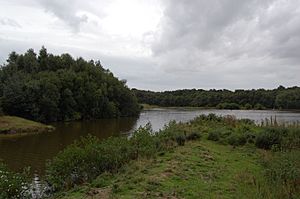Mere Sands Wood facts for kids
Quick facts for kids Mere Sands Wood |
|
|---|---|

The main lake
|
|
| Lua error in Module:Location_map at line 420: attempt to index field 'wikibase' (a nil value). | |
| Created | 1982 |
| Operated by | Wildlife Trust for Lancashire, Manchester and North Merseyside |
| Status | SSSI |
| Website | Official site: http://www.lancswt.org.uk/reserves/mere-sands-wood-nature-reserve |
Mere Sands Wood is a special place in west Lancashire, England. It's a nature reserve that covers about 105 acres. This amazing area is looked after by The Wildlife Trust for Lancashire, Manchester & North Merseyside. You can find it between the villages of Holmeswood and Rufford, not too far from Ormskirk. The name "Mere Sands Wood" comes from a time when this land was right next to a big lake called Martin Mere.
Contents
Mere Sands Wood: A Nature Reserve
This nature reserve is a fantastic mix of different natural areas. It has calm lakes, thick woodlands with both broadleaf and conifer trees, and even sandy, wet meadows and heaths. All these different habitats sit on layers of sand and peat. These layers were left behind after the last Ice Age, on top of a type of clay called boulder clay.
The reserve is about 105 acres in size. It has a special visitors' centre where you can learn more. There are also two nature trails for you to explore. If you want to get a closer look at the animals without disturbing them, there are six wildlife hides and one viewing platform.
Amazing Wildlife at Mere Sands Wood
Mere Sands Wood is a busy place for many different creatures!
Birds
Over 170 types of birds have been seen here. About 60 of these bird species even choose to build their nests and raise their young at the reserve. Keep an eye out for them!
Mammals
You might be lucky enough to spot some mammals too. Roe deer, stoats, and foxes are often seen roaming around. In total, 17 different kinds of mammals live in the area. This includes a small group of special red squirrels. They love to live in the Scots Pine trees.
Insects
If you like insects, you'll be excited to know that 15 different types of dragonfly live at the reserve. Ten of these dragonfly species actually breed there, laying their eggs and starting their life cycle.
Plants and Fungi
The woodlands are mostly filled with birch and oak trees. There's also a special area with Scots Pine trees, which is where the red squirrels like to hang out. Beyond the trees, Mere Sands Wood is home to an incredible 200 different kinds of fungi.
History of Mere Sands Wood
Mere Sands Wood has a long and interesting past.
From Ancient Lake to Modern Reserve
Long ago, this area was part of a huge lake called Martin Mere. This lake was once about 15 miles around! Some old stories even link the lake to the legendary King Arthur. For many centuries, from the time of the Anglo-Saxons up to the late 1800s, the lake was used for fishery. People would catch fresh water fish and eels there.
From Quarry to Nature Haven
Later, between 1974 and 1982, the land was used as a sand quarry. The sand dug from here was used to make glass. But there was a plan in place: once the sand digging was finished, the site would be turned into a nature reserve.
In 1982, The Wildlife Trust for Lancashire, Manchester & North Merseyside took over the site. They worked hard to transform it into the beautiful reserve we see today. In 1985, Mere Sands Wood was officially named a Site of Special Scientific Interest (SSSI). This means it's a very important place because of its unique geology. Today, tens of thousands of people visit Mere Sands Wood every year to enjoy its nature and wildlife.

